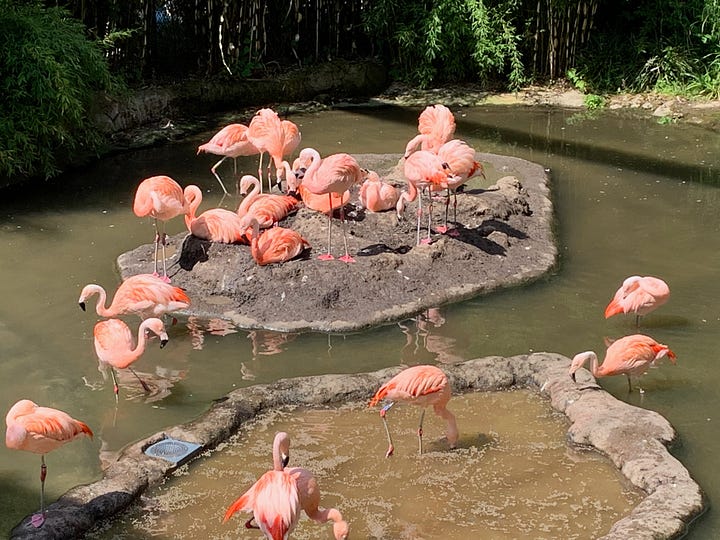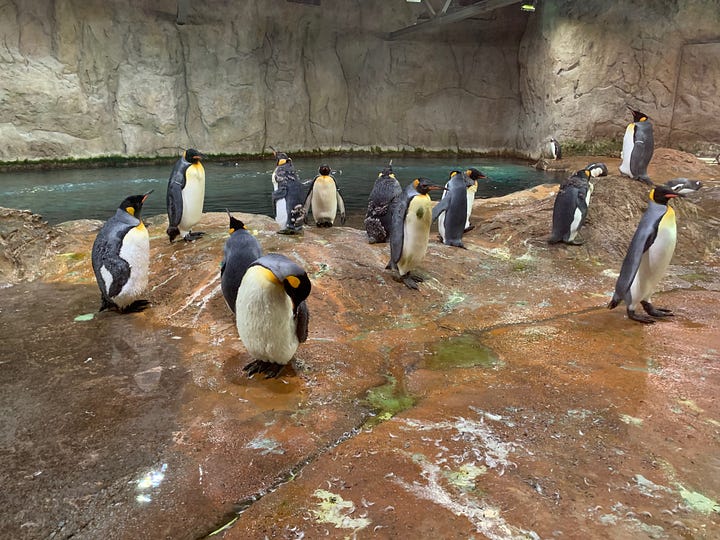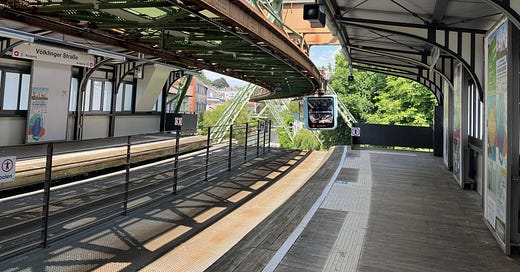Wuppertal and the Oldest Electric Suspension Railway in the World
Wuppertal is definitely one of the most fun places we have been to in Germany this summer. It not only boasts the Schwebebahn, the oldest electric suspension railway in the world (and the only one in Germany), it also has a really amazing zoo that is extremely accessible via public transport.
The Schwebebahn is also not just the only thing interesting about the city. For one, Wuppertal as a city is relatively young, only formed in 1929. By decree, the two bigger industrial cities of Elberfeld, Barmen, and a collection of the nearby smaller towns Ronsdorf, Cronenberg, and Vohwinkel were merged together as one — Wuppertal.
The surrounding regions of Wuppertal are also particularly hilly, and hence most of the city straddles both sides of the Wupper tributary of the Rhine river linearly. This makes for a pretty different experience exploring the city, as you often find yourself crossing some bridge to the other side to get to your destination.
Despite it being an agglomeration of two cities and other smaller towns, Wuppertal is no big city at all. It has a population of only about 350 thousand, which is almost half the number of people in Düsseldorf. Outside of the old town area near the main station, the rest of the city is rather quiet, making it a pleasant experience to explore the city on foot. You can never really get lost as the Wupper is always in sight should you need to orientate yourself.
Getting to Wuppertal
Its smaller size does not affect its accessibility though as Wuppertal is well-connected whether you are driving (A46 Autobahn) or taking the train. From Düsseldorf, there are numerous regional trains taking passengers to-and-fro both cities daily in just about half an hour although we went with the S8 S-bahn as we wanted to stop by the zoo first.
Wuppertal Zoo
The NRW region of Germany is well-known for its numerous zoos and Wuppertal’s is one of the more popular ones. Because of the hilly geography, the zoo is also a mountainous zoo, making it one of the more unique zoos in Germany. Walking in the zoo is fun and feels a lot like hiking, but do take note as it can be tiring with a stroller or if you’re wearing your baby!
Getting to the zoo is easy though as it is located a few minutes walk from the Wuppertal Zoologischer Garten S-bahn station. If you’re travelling from the city, you can also take the cooler option of the Schwebebahn (more on that later).
The zoo is also pretty big, housing over 500 species of animals so definitely do budget enough time if you or your little one is a big animal lover! We spent around 5 hours in the zoo and still left without seeing some animals as Ethan was already getting pretty restless by then. Still, it was a really amazing experience especially for Ethan.
Some of the areas are very well-designed to let you get really close to the animals. Ethan was very amazed by the parrot/flamingo area near the entrance. You go into a very big enclosed dome where the birds are quite free to fly around. There were a few occasions where we were just inches away from the birds.


Other “classic” animals were also a delight — gorillas, elephants, giraffes etc. Ethan was a little disappointed that we weren’t able to spot the lions and tigers though.
The biggest highlight for us were the penguins however. Their enclosure was huge, housing what looked like a mini-city of penguins. There is also an “underwater” level where you can marvel at the penguins swimming gracefully in the water. We had a lot of trouble convincing Ethan to move on even after 15 minutes there of him exclaiming and pointing to the different penguins swimming past us.


Zipping around in the Schwebebahn
What else other than large moving machines could interest young boys apart from animals? That is why we took our young train Otaku to see and experience the most unique railway system in Germany — the Wuppertal Schwebebahn (or suspension monorail).
First built in the 1890s, the Schwebebahn is a real engineering marvel to behold. It is not only still working today, but it is the main public transportation tool carrying Wuppertal citizens around everyday!
The Schwebebahn very sensibly runs along the Wupper river for the most part of its service line, keeping both parts of the city on each side connected. This also makes for a wonderful riding experience as the views of the Wupper as you’re suspended above it is just magnificent.

The Schwebebahn is public transportation, so riding it is the same as you would for the U-bahn in other German cities. Of course it is even more straightforward if you have the Deutschlandticket.
It is also a great way to explore and see the city as it is just one line, and you can go from one end to the other in just 30 minutes. Highly recommended to not do this during peak hours though as the trains are small and it can get pretty crowded.
Concluding thoughts
We stayed over in Wuppertal for just one night before heading back to Düsseldorf, mainly because we wanted Ethan to be able to rest adequately. A day-trip is definitely doable especially if you’re driving.
Honestly though, as much as we really enjoyed the zoo and the novel experience of riding the Schwebebahn, we were not really a big fan of the rest of the city as a day-trip destination. Besides the rather crowded city centre, there was not a lot else going for families.
However, if there is still time in your itinerary, one good option is to head to Vohwinkel via the Schwebebahn and take the bus down to Gräfrath, a very beautiful historic neighbourhood in Solingen.
Ethan really enjoyed the zoo and we definitely see ourselves going back again in the near future, perhaps to try and spot those tigers and lions that we missed this time round!




